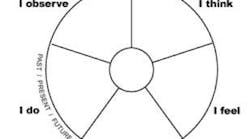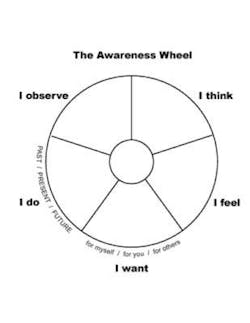What Goes Around Comes Around: Keep Practice Communication on Track with the Awareness Wheel!
Keep Practice Communication on Track With the Awareness Wheel
by Fran Pangakis, RDH, and Shari Tastad, RHD, BS
Congratulations! You just completed a very productive morning schedule. You’re feeling great! Your career in dentistry is just what you dreamed it would be . . . or is it?
You reluctantly walk into staff meeting (not your favorite part of owning a practice) and “it” begins. You remind your hygienist to take digital photos on recare patients. In a flash, her arms go up, her eye contact intensifies, her face turns red, and she frantically replies, “I don’t have time.” Communication quickly comes to a standstill and you decide it just isn’t worth spending more time on the issue. You retreat and decide to do it on your own (or not at all). This recurring breakdown of communication confirms to you that staff meetings ARE a waste of time!
Communication is a tool we take for granted and something we don’t learn in dental school. It takes practice. But it’s worth the work. The ability to process and facilitate “people information” (information about self, others, and interactions) will bring you more meaningful experiences, good feelings, and better connections with others than any other skill. To build this skill requires awareness. Keys to clear communication revolve around being able to verbalize what you observe, think, feel, want, and are willing to do.
Good solutions to topical, personal, and relational issues grow out of the rich soil of complete and congruent awareness of self and others. For complete and honest communication, it is important to start with five key pieces of information: what you see, think, feel, want, and are willing to do. All are distinct yet interact with each other. By using a tool called “The Awareness Wheel,” you can learn to more effectively process important information about yourself and others.
In the example staff meeting the doctor asked the hygienist to take digital photos (what the doctor wanted) and the hygienist said she had no time (what she was thinking). Many pieces of the communication are missing from this interaction that would have helped each person understand the other at a deeper level and improve communication in the office. The more you know about yourself and others at any moment, the more effectively you will communicate in a variety of critical situations. As a leader you are the person to make the difference. By learning to bridge impasses, you will initiate change in your dental office.
One of the tools we train our teams/clients to use during potentially conflict-based conversations is the five-step Awareness Wheel. When all five steps are used it allows one to communicate an entire message and promotes more effective listening.
Imagine having the five steps of the awareness wheel tattooed on your forehead. All information passes through the wheel, step-by-step, as it is received and delivered. If your goal is to reduce misunderstandings, build stronger relationships, and minimize conflict situations, the awareness wheel is ideal.
The spokes of the wheel are as follows:
Observing: What do you observe about yourself and the other person? Observations include verbal and non-verbal data taken in through the senses: sight, sound, touch, smell, and taste. Your senses are like a good journalist. They observe, report, and describe, but they do not interpret. There are three major elements in spoken communications, though they have a disproportionate impact on what is received and believed. What is actually said accounts for only a fraction of the message. We put more stock in the way something is said, its vocal and tonal message (remember the admonishment from your mother: it’s not what she said but how she said it). But by far the greatest influence in communication is the visual impact (what is seen). Without ever hearing a word, you make meaning from various kinds of visual data: context, time, space, texture, design, accessories, clothing, and body language, among others.
In our opening scenario the doctor may have noticed the hygienist’s rate of speech, flashing eyes, flush skin, and intense voice. The hygienist might have noticed the dentist’s posture, composure, and tone of his voice.
Look and listen for signs in yourself and the other person.
Tips to consider:
1. Notice individual patterns. Everybody has a body signature.
2. Let yourself see and hear all the data.
3. Pay attention to conflicting data — saying one thing verbally and conveying something different in body language. Remember, the body speaks its mind!
Thinking: What do you think is going on? This “meaning” contributes to your reaction. Your beliefs, interpretations, expectations, ideas, opinions, and theories influence your perception of sensory data. Thoughts are influenced by your past, present, and anticipated experiences. Your beliefs set the parameters for what you think is possible, how you feel, and what you want. Your interpretations represent how you put the world together. Your expectations are how you organize the future.
Perhaps the doctor expected the hygienist to say “No way!” and therefore made the request in a less than positive manner. His beliefs and expectations sabotaged his attempt to communicate.
Tips to consider:
1. Treat your beliefs and interpretations as working hypotheses.
2. Consider the possibilities. Several interpretations may be possible.
3. Be aware of your beliefs and expectations as you approach a new situation.
4. Prepare to switch. Could you possibly change your belief or change your expectation?
5. Ask yourself: “How are my thoughts influencing what can happen in this situation? Are they limiting?”
Feeling: What do you feel? Feelings are your spontaneous internal, physical, and emotional responses to the comparison between what you expect and what you experience. Some people consider feelings to be risky, irrational, and dangerous. As a result, they fear their feelings, do not trust them, and try to ignore them. But if you study your feelings and feel without acting, you’ll discover that your feelings are actually very predictable and rational. They come from somewhere, and how you act on them can have a positive or negative influence on a situation.
Feelings are information. Your feelings, whatever they are, draw from other parts of your awareness. They are information about you at that moment, important in their own right. They do not have to be justified, denied, or avoided. They are part of “what is.”
Several feelings can arise at the same time. They can be a combination of positive and negative feelings. For example, it is possible to feel frustrated, disappointed, and hopeful all at the same time. One cannot control feelings by ignoring them, nor can you do away with them by denying them. Sooner or later they will come up to haunt you. Rather than disregard your feelings — negative as well as positive — see them as internal clues to “what’s happening.” They are your barometer; they take readings on your external and internal world. By acknowledging your feelings, you are taking control of your world.
Words that describe feelings are angry, happy, afraid, bored, excited, disappointed, concerned, and anxious.
Tips to consider:
1. Attend to your feelings. Ask yourself, “What am I feeling?” Put it in words.
2. Tune into your body. What do recurring physical sensations tell you?
3. Learn about your responses. How you respond to others reveals how you are feeling.
4. Change your activity to change your feelings.
Want: What do you want? Define your real intention. Wants are your desires, hopes, and wishes for you, others, and your relationships. As such, they reflect your core values. Wants can be tentative hopes and dreams or deep desires of the heart. They imply moving towards or away from something or someone. Wants are motivators. They give you a tentative direction for the future. They may be your mini plans, goals, objectives, or priorities.
Wants are important for two reasons:
1) Over the long term, they demonstrate your real (not just stated) values, and
2) They propel action. When you connect with what you really want, you focus your energy and release a strong force.
You can have wants for yourself, for others, and for us. People usually have multiple wants. In our example the dentist has several wants — to give the patient the best care (desire for self and others), to increase production (for us), and for his staff to participate at a different level (for self and others).
Tips to consider:
1. Ask yourself from time to time, “What do I reallywant?” This will give you increased energy.
2. Discover the wants of your team/others. This will assist you in motivating them.
3. Clarify wants (your own and others) to reduce confusion.
4. Check for hidden wants when you’re feeling desperate. Are they keeping you stuck?
5. Use awareness of your intentions to help you send clearer messages, using an appropriate style of communication.
Action: What do you do? How do you proceed to ensure that the request is followed through or behavior is enhanced or changed? As you act, consider what you have done in the past, what you are doing now, and what you are willing to do to go forward.
Actions are behaviors, activities, actions plans, solutions, promises, achievements, and accomplishments.
Tips to consider:
1. Be honest in talking about what you have done in the past and what you are willing to do differently.
2. Be realistic.







